In a previous article (Growing fruit trees in containers-there’s a fruit tree for you) fruit trees that can be grown in containers was discussed. It is now time to turn our concentration and attention to growing soft fruit in containers.
Soft fruit tends not to grow as big as fruit trees, and therefore more types can be grown in containers. You can grow blackberries, raspberries, blueberries, cranberries, lingonberries, blackcurrant, redcurrant, white currant, gooseberries, goji berries, and grapes.
What follows is a discussion of what soft fruits can be planted in containers and the best way of doing this.
BLACKBERRY AND ITS HYBRIDS
The sad fact is that most blackberry and its hybrids cannot be grown in containers. They, in fact, need a small garden with a fence in order to grow well. You need 3.5m of fence to produce enough crop for a family. This is not feasible in most container gardens.
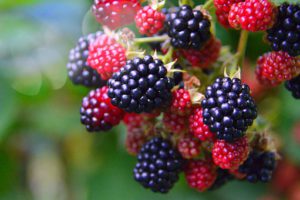
All that has changed, as plant breeders have developed small bush types that can be successfully grown in containers. This is because blackberry ‘opal’ has been developed.
It has a compact, upright habit, where it will grow up to 90cm high and wide. The extra bonus is that the plants are thornless. Its fruit is produced in late summer to early autumn, making it suitable for all blackberry lovers. Another similar variety is called blackberry ‘little Black Prince’.
There has even been a variety of blackberry that can be grown in hanging baskets, and this is aptly known as blackberry ‘Cascade.’ The plant grows up to 30cm in height and 45cm in width. Blackberry yields per plant are 1.3kg, which is quite healthy for such a small plant. Cascade plant is also thornless and it is recommended that it is planted in a 40cm diameter hanging basket. It appreciated being grown in a rich multipurpose compost, where added water retaining crystals have been added.
RASPBERRY
It is possible to grow traditional raspberry canes in containers, but you will need a large container that is 60cm square and 45cm deep. They prefer to be grown in the ground. If you are using a container that you need to use a sandy multipurpose compost, which had been enriched with organic material.
This is not practical for most container gardens, and until now you would have to do without. The good news is that plant breeders have developed a compact variety, called ‘red Ruby’.
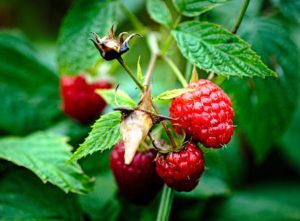
Like the blackberry varieties, it is thornless where it grows up to 1m high, producing 1.5kg of fruit per plant. It needs no support and is ideal for containers. It can even be used to form an edible hedge.
It is a floricane raspberry that it will fruit on last year’s stems in summer. In autumn you need to cut the fruited stems to the ground, leaving the new canes to crop in the next year. Every month during the growing season it requires feeding with a general liquid fertilizer. Extra watering in the summer months will be required to help the fruit swell. Bird protection in summer may be required, so use netting, which is easy for a small plant like this.
BLACKCURRANT
This fruit requires some sugar to make it more palatable to people. It is mainly used in the manufacture of blackcurrant juice after all a well-known brand uses 95% of the blackcurrants commercially grown in the UK.
One bush can produce 4.5kg of fruit and as all of them are self-fertile, then you will only need one bush per family. They are not normally grown in containers, but compact varieties such as Ben Sarek, Ben Gairn, and Ben Connan can be grown in containers.
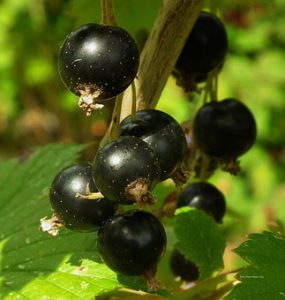
They really appreciate growing in a large container, such as a half barrel size in order for the plant to do well.
Blackcurrants like rich compost, so it is best to use multipurpose compost, mixed with slow release fertilizer and water retaining crystals.
Normally you buy a plant in winter to plant between November and March, but a container bought specimen can be planted at any time. It is best to plant the blackcurrant 2.5cm deeper than they were in the nursery. This will aid new shoots formation. All the shoots just above the second bud above the ground need to be cut to that bud. This will promote root growth and therefore more new shoot formation. It sounds harsh but it must be done.
For the first year, feed monthly with a general liquid fertilizer, and water very well. In its second year in winter, you need to adopt a pruning regime to keep the plant productive. Cut away any damaged or crossing branches, before removing a quarter of the old stems, creating an open structure in the centre.
The problem with blackcurrants are the birds love them, so netting is required to protect your crops.
REDCURRANTS AND WHITE CURRANTS
You can grow red currants and white currents in containers and they can be trained against a fence or wall, in the form of a fan or cordon. For best results, grow in the compost mixture recommended for black currants
In late winter each year, you need to feed with a general fertilizer around the plant to encourage new growth. Every month during spring and summer feed with a liquid general fertilizer to encourage fruiting.
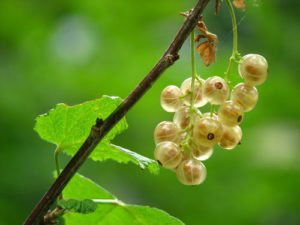
In the first winter after planting the main stems need to be cut back to about half its length, just above an outward facing bud. Regular pruning should be carried out in winter when the plant is dormant. The exact method used is dependent on which structure is required.

Pruning to two side shoots will concentrate growth and stop it from becoming straggly. Red currants fruits on old wood, so do not prune too hard. Red currants can produce a heavy crop, and so branches may need to be supported by using canes and plant ties.
Check currants for ripeness by tasting the berries. They may look ripe but in fact, are still sour. Wait two weeks before picking the fruits. White currant are the same are red currants, the only difference is the colour of the fruit.
For pot growing Stanza is recommended for its compactness and heavy cropping. As with all soft fruit plants it will need netting in order to protect the birds from stealing your fruit.
BLUEBERRY AND ITS COUSIN BILBERRY
Bilberry is our native plant in the UK, where it grows wild in boggy acidic soil. They are small plants with small fruits. You can grow them in containers but you need a lot of plants to produce a decent crop, so it is better to grow its American cousin the blueberry.
Blueberry has been classified as a superfood and along with this many health benefits that are claimed from improved vision and better memory.

The natural growing conditions for blueberries are acidic wet soils, which is easier to replicate in a container. They like wet soil but not soggy soil, so it is important that you get the drainage right.
If you are using an unglazed terracotta pot, which allows water to percolate through the ceramics and then evaporate. This can be reduced by using a liner made out of polythene, with punched holes to aid drainage. Plastic pots are better and so will be recommended for growing blueberries.
HOW TO PLANT BLUEBERRIES AND BILBERRIES
When planting in containers use a 1cm layer of fine gravel as a mulch to reduce evaporation and stop weeds from growing underneath the plant.
You need an ericaceous compost of a pH between 4.5 to 5.0. This is the preferred pH for boggy loving plants, such as cranberries, blueberries and lingonberries, and other edible bog berries.
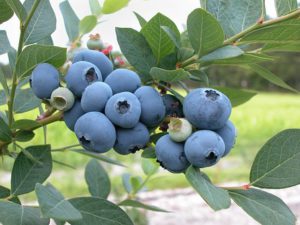
It is best to mix ericaceous compost with a generous amount of water retaining crystals. Blueberry plants need to be watered with rainwater rather than tap water, especially if you live in a hard water area. This is not much so if you are lucky enough to live in a soft water area, where the pH is more neutral.
The plant does not need much feeding as it has adapted to grow in a low nutrient environment. If it looks a little sickly, you can feed with a liquid ericaceous fertilizer.
If the pH starts to slowly rise after a couple of years, you can add sulphate of iron to lower the pH of the compost.
Blueberries are partially self-fertile in that you will get a small crop with one plant. Ideally to get a large crop you need to plant two or more different varieties of blueberry plants are required.
A 30cm diameter pot is the absolute minimum, but as the shrub gets larger you can move the plant to the next available pot size up.
HOW TO LOOK AFTER BLUEBERRIES
In late winter, remove one or two of the older stems to encourage new stems to grow. Prune back the new shoots to a couple of buds from the top, as this will encourage side shoots to develop.
As two plants are required as a minimum, then a spacing of 60cm is required between each blueberry container. This is to allow each blueberry plant to fully develop and in order to avoid the branches of the blueberry plants from getting entangled.
CRANBERRIES
This berry which has become compulsory with your Christmas turkey is another superfood that is beneficial for everybody’s health.
Cranberries require the same growing conditions as blueberries, so I will not repeat what compost to use or what regime feeding regime that is required, once again.
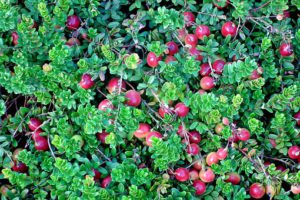
They are a low growing plant, and as such, you can grow them in a hanging basket, window boxes, as well as pots. Cranberries can even grow under trees, so do well in shady areas of the garden, as well as in full sun.
Once fruited in early autumn you can give the plants a decent trim with secateurs to keep them tidy, and to encourage them to bush out.
GOJI BERRIES
These berries full of antioxidants is another superfood that has been bandied around for a number of years, It is an acquired taste, so go into a health food store and try some before buying a plant.
They are tricky to grow from seed, so buy a young plant from a reputable supplier. It is, in fact, a member of the Solanaceae family, from which tomatoes, peppers, chilies, aubergines, and potatoes come from.

These attractive looking plants come from the Himalayas and therefore tough and hardy. They prefer a rich compost in a sunny position. It is best to mix a multipurpose compost with a slow release fertilizer to ensure a decent crop. Goji berries need watering at the fruit swelling stage, but at all time the compost must be moist.
They take a couple of years to start fruiting, but after 4 years it will reach maximum fruit production capabilities. The flowers appear in early summer and so are not killed by frosts. Goji berries are ready to harvest in late autumn. The berries can be dried and stored for use in winter.
GOOSEBERRIES
The French call it the ‘English fruit’ which is an appropriate name for it, as the British love it in pies, fools, and jams.
You can grow as a full bush or a half standard. The half standard is a straight stem running up to 0.5m in length, from which a bush grows at the top. It is quite similar to a decorative bay leaf tree
The problem with gooseberries is that they have vicious thorns that can puncture gloved hands easily. Do not put off pruning because of this, as you will end up with a tangled mess of a gooseberry bush growing.
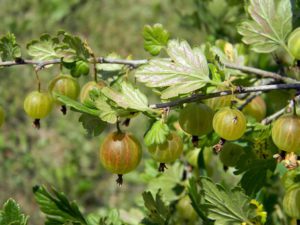
A half standard in a pot can be pruned easily by rotating the pot, as you snip it. This will stop yourself from getting injured in order to reach the other side of the shrub,
They grow well in the shade and can thrive on a North-facing wall. This will free up space and you can plant a productive plant in a space which otherwise would be vacant.
They like a rich compost, similar to that for currants and goji berries, as long as plenty of nutrients is available to the plant, to keep it productive.
The large berries take some time to mature on the bush, The berries themselves can be green, yellow or red in colour, so you have a choice of what to choose from. The early immature pickings are suitable for making jam, whilst the sweeter more mature berries are ideal in fools,
A number of varieties are available but I would recommend that you buy a half standard to save your fingers from getting pricked.
GRAPES
Grapes are ideal in a small garden, as it is a climbing plant (a vine). All that is required is a large container. I would grow grapes in a 60cm diameter pot, which has a 45cm depth. It must contain around 60 litres of compost in order to do well.
Drainage is very important, so use gravel or broken crocks to help the excess water to drain away.
Ideally, a good quality multipurpose compost mixed with some topsoil should be used. This will give the grapevine a good start.
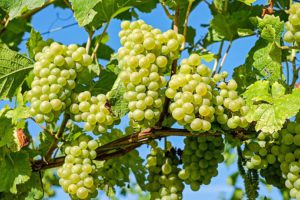
Once established the plant will set down roots which go seeking nutrients in the soil. This is a problem for container bound specimens, where the nutrients will not be available. So every year it must be fed with a high potash general fertilizer. You will need a good pergola or framework from which the vines will hang on to.
PRUNING AND LOOKING AFTER THE GRAPES
Pruning should be undertaken in winter when the leaves have fallen as they will bleed otherwise and lose strength. To keep it simple, leave the shoots you want to grow up and over the pergola or framework. You can even grow the vines up a trellis on a wall.
Trim unwanted side-shoots to 2.5cm from the main stem. The leading stems can be cut to the length that you require, as long as it is cut close to a bud.
If you are growing a dessert grape, then you are supposed to reduce the number of grapes in the bunch using special scissors. This is done to make the remaining grapes grow to a larger size. This is great if you have plenty of time but can become tiresome if you do not. Some people skip this step and still get a decent crop.
You can also grow wine grapes as something in between dessert and wine. The choice of which to buy is so dependent on where you live. The dessert grapes prefer the warmth and protection of a greenhouse in order to be reliable, whilst wine grapes can be grown outside. All grapes can be grown in a sheltered sunny spot in the south of the UK.
LINGONBERRIES
These berries are often eaten in Scandinavian countries, where it is made into a jam. It is often consumed with meat dishes, especially meatballs. Just think about a trip to IKEA and those meatballs served with lingonberry jam.
They grow wildly in Scandinavia countries, where the fruit is picked from forests where it grows like a weed. They are grown in exactly the same way as cranberries to which they are related too. They are very hardy and frosts will not damage them.
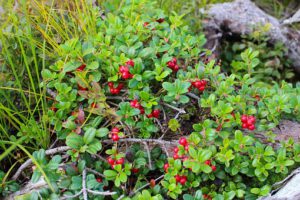
If you want to propagate both lingonberries and cranberries, you can and it is easy to do. In autumn when the compost is still warm remove the plant from the container, and tease the roots apart. Whilst doing this discard the woody central clump, and re-pot sections of the younger roots. Water well and next year you will have additional new plants ready to crop.
Cranberry and lingonberry are both self-fertile and require no other partners for pollination
STRAWBERRIES
Strawberries are one fruit that really enjoys being grown in small spaces. There is nothing to beat the taste of a strawberry plucked straight from a plant or enjoying strawberry jam in winter.
Strawberry plants in containers will give more yield per square metre than those planted in a strawberry bed, plus less cultivation is required. It is also noticed that strawberries in containers also experience fewer attacks from pests, but the only problem being the birds eating the fruit from above, and the slugs attacking the fruit from below.
Netting will keep the birds away from the fruit, whilst slug pellets will protect the crop below.
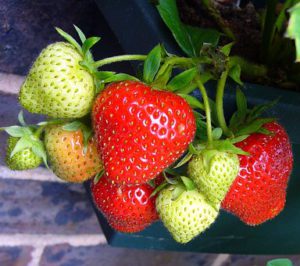
You can grow strawberries in almost any container, including hanging baskets. You can even grow them using a vertical pocket hanging wall planters, where it looks stunning with all the fruit hanging from them.
The most economical way of growing strawberry plants is in a Victorian style planter. This will be reviewed in a forthcoming article.
Try to avoid ceramic or terracotta planters, as they do not hold too much compost and the plants, in general, do not do well. Drying is a common problem with these planters.
WHY YOU SHOULD NOT GROW STRAWBERRY FROM SEEDS
You can grow strawberry plants from seed but it is much easier to buy plant directly from suppliers. Alpine strawberries are different as you can grow these from seed, and they will produce their fruit in one year, before dying.
After three years strawberry plants start to become less productive and so will need replacing. This is no problem, as most strawberries produce little strawberry plants on their lengths, which are called runners.
In its first year, all runners should be removed as soon as they are noticed. This is done to get the plants established and fruiting.
From the second and third years allow the runners to grow. Place a piece of wire, bent into a V-shape to clip the small plants on the runner down to an 8cm pot full of compost. Discard any more plants growing on the runner so that you only have one plant in compost per runner. It will take around six to eight weeks before the plant would have rooted, and then you can cut away from the mother plant.
HOW TO PLANT AND LOOK AFTER STRAWBERRIES
Strawberries appreciate being planted in a mix of 2 parts multipurpose compost and 1 part vermiculite, mixed along with slow release fertilizer. Thereafter, once a month during the growing season, feed with liquid tomato fertilizer. It is better to start afresh using new compost, once every three years.
After fruiting when the leaves start turning yellow then it needs to be cropped to the ground. This will ensure that no pests were hiding and that next year’s growth will be strong.
There is a range of strawberry plants available to buy. Summer fruiting strawberries produce their fruit over 2 to 3 weeks, and come in early, mid or late season varieties. This is according to when in summer the fruits are harvested. Perpetual strawberries produce small flushes of fruit throughout the growing season, but less fruit is produced overall compared to the summer varieties.
They are a number of varieties that you can grow, all suitable for containers. It is up to you to find the strawberries that you and your family prefer.
You can have strawberries that cover all summer, if you plant early, mid, late and perpetual strawberries.
CONCLUSIONS
In this article, the suitability of soft fruit plants in containers has been highlighted. As you can see there is numerous soft fruit that can be successfully grown in containers, covering a wide range of colour and tastes. The choice of what to grow is left to you the reader.
As ever if you have any questions or comments that you wish to make, please leave them in the comment box below.
Happy fruit growing.


Thank you so much for this post. I thoroughly enjoyed reading, particularly about the strawberries and the blueberries, both of which I already have in pots. I have new knowledge on how to get them thriving now! Both plants are in their second year, and the blueberries did well this year, albeit I didn’t prune them back at the end of winter. The strawberries, did really well their first season, but this season they didn’t thrive, but I think that might perhaps be because I allowed the runners to fill up their pot in the first season… whoopsidaisy!
Hi Josie
Thank you very much for those kind words and I really appreciate that you got something new from the article. If you use everything from it you will produce bumper crops in many years to come.
Kind Regards
Antonio
Berries in containers? Ah, how the world has changed! My daughter lives in an apartment, but she is blessed in a way because her landlord has allowed her to use the roof outside her window for containers for plants. She is wanting to grow some veggies, and I know berries would be something she would love, but we didn’t think she’d be able to do. Now, it looks like, she will be able to, and you say there are some she can grow in hanging baskets? This is definitely good news! Thanks!
Hi Babsie
If your daughter has limited growing it is packed full of information on how to grow veg in small spaces, she will find my guide on growing many types of vegetables in container useful. I also have a guide on how to grow potatoes and tomatoes in containers. Soft fruit will add a colourful addittion to any container gardener.
Thank you for those kind words
Antonio
I’m so happy I found your site! I love gardening however, I’m not always the best at getting a good crop from my plants. With the tips on your page I feel like I might finally get that great garden going this year. One question though – I would love to plant blueberries; You suggest planning several varieties to get a bigger crop. Which varieties do you recommend for the best crop, preferably with larger berries? Thanks again!
Hi Shannon
I think everybody loves blueberries and I am no exception. Blueberries tend to do better in threes, but you can get away with two if you do not have the room. I would recommend ‘Bluecrop’ that have large berries, ‘Sunshine Blue’ for its heavy crops and ‘Top Hat’ for its flavour. As long as they flower roughly at the same time, then you will get a good decent crop.
Kind Regards
Antonio
Thanks for this amazing article, I love my soft fruits and eat them all year round. I don’t have much room in my garden so having this information about using containers with be very handy. I will certainly be trying to grow some of these. Raspberries, Strawberries and Blueberries are my favourites. Would you be able to grow these in the same container?
Hi Martin
Thank you for those kind words, they are very much appreciated. Soft fruits are delicious no matter what you grow, the only problem is that the growing season is short for most of them, This can be gotten around by freezing most of your crops, great if you want to make a fruit packed smoothie.
The answer to your question is no, most soft fruit will need to grow in individual containers, as they have specific growing requirements. Saying that cranberries and blueberries can be grown in the same pot.
Kind Regards
Antonio